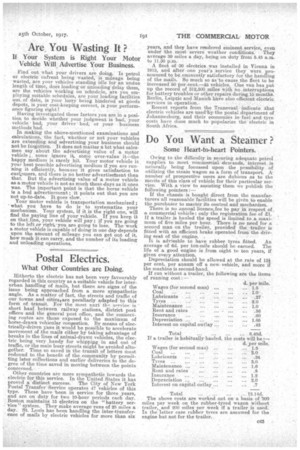Postal Electrics.
Page 13

If you've noticed an error in this article please click here to report it so we can fix it.
What Other Countries are Doing.
Hitherto the electric has not been very favourably regarded in this eountry as a suitable vehicle for interurban handling of mails, but there are signs of the issue being approached from a more sympathetic angle. As a matter of fact, the streets and traffic of our towns and citiestare peculiarly adapted to this form of transit. For the most part the service is short haul between railway stations, district post offices and the general post office, and the connecting routes are those exposed to the maximum of horse-drawn vehicular congestion. By means of electrically-driven yans it would be possible to accelerate movement of the mails either by taking advantage of breaks in the lines of animal-drawn vehicles, the electric being very handy for whipping in and out of traffic, or the main busy streets might be avoided altogether. Time so saved in the transit of letters Must redound to the benefit of the community bypermitting later collections and earlier deliveries to the degree of the time saved in moving between the points concerned.
Other countries are more sympathetic towards the electric for this service. In the United States it has proved a distinct success. The City of New York I3ostaI Transfer Service operates 47 vehicles of this type. These have been in service for three years, and are on duty for two 10-hour periods each day. Boston maintains 15 electrics on the "battery service" system. They make average runs of 25 miles a day. St. Louis has been handling the inter-fransference of mails by electric vehicles for more than six years, and they have rendered eminent service, even under the most severe weather conditions. They average 30 miles a day, being on duty from 5.45 a.m. to 11.30 pm. A fleet of 30 electrics was installed in Vienna in 1913, and after one year' a service they were pronounced to be ,eminently satisfactory for the handling of the mails. So much so as'to cause the fleet to be increased 50 pereent.-45 vehicles. One van has put up the record of 312,500 miles with no interruptions for battery troubles or other repairs during n months. Leipzic and Munich have also efficient electric services in operation.
Recent reports from the Transvaal indicate that electric vehicles are used'ty-the postal department of Johannesburg, and their economies in fuel and tyre costs have done much to popularize the electric in South Africa.






















